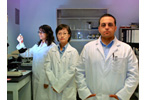Mold
What is it?
Molds are tiny organisms that are found everywhere in nature, and hundreds of thousands of individual species of molds naturally exist in the environment. Molds come from the Fungi Kingdom (Fungi is one of the five Kingdoms in the classification of living things on Earth) and therefore the terms “mold” and “fungi” are used interchangeably. Fungi exist in many different forms but two of which are most commonly encountered; there are funguses (macro-fungi) that appear as fruiting bodies such as mushrooms or wood decay fungi, and there are molds (micro-fungi) that appear as fuzzy patches of discoloration such as moldy bread/oranges or visible growth on building materials like drywall. Molds and fungi release tiny seed-like particles called “spores” for germination and therefore become airborne.
What regulations exist to
control Mold?
Currently, there are no Federal or State laws or regulations that regulate the presence, exposure levels, or removal of mold. However, in the mold testing and removal industry, there are recognized standards and guidelines that exist that provide a “standard of care”. Some laws are in effect that mandate full disclosure in real estate transactions with regards to water damage and/or the presence of mold in a home or office to potential new buyers.
How does Envirocheck, Inc.
test for Mold?
Envirocheck, Inc. offers many services to test for mold presence in a home or office. Envirocheck, Inc. can test for the presence of mold in the air, take surface samples of suspected mold growth areas for identification, and collect intrusive samples (e.g. wall or ceiling cavity samples) in an attempt to determine the source of mold infestation in a home/office. If mold is detected, Envirocheck, Inc. offers consulting services aimed at eliminating mold problems in the affected areas. Lastly, Envirocheck, Inc. can test for air quality and determine whether or not an area previously affected by mold has been properly cleaned. Envirocheck, Inc. has an AIHA accredited laboratory on-site for the analysis of these various samples.

 Where is it found?
Where is it found?